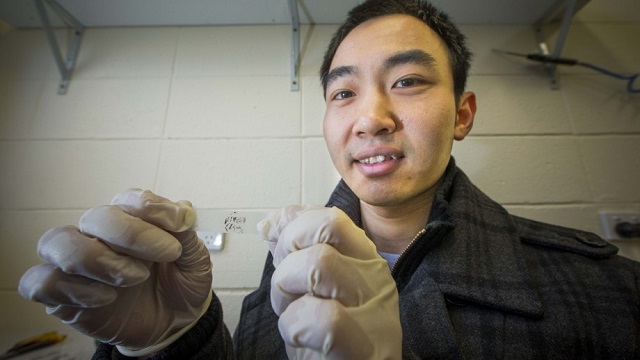 Dr Yuerui Lu (left), Jiajie Pei (Front) and Renjing Xu. Image credit: Stuart Hay, ANU
Dr Yuerui Lu (left), Jiajie Pei (Front) and Renjing Xu. Image credit: Stuart Hay, ANU
Researchers at Australian National University have analyzed thin layers of phosphorus and found they possess unique properties which are likely to pave the way for ultrathin and ultralight solar cells and LEDs.
The researchers used sticky tape to produce single-atom thick layers called phosphorene in a similar manner as the Nobel Prize-winning graphene discovery. However unlike graphene, but like silicon, phosphorene is a semiconductor.
Because phosphorene is so thin and light, it creates possibilities for making lots of interesting devices, such as LEDs or solar cells. It shows very promising light emission properties.
Dr Yuerui (Larry) Lu, from The Australian National University (ANU)
Phosphorene was created by the team by using sticky tape for repeatedly peeling thinner and thinner crystal layers from the black crystalline form of phosphorus.
Phosphorene can be used to create thinner and lighter semiconductors compared to silicon. Furthermore its light emission properties tend to differ based on the thickness of the layers, which provide better flexibility for manufacturing.
This property has never been reported before in any other material.
Dr Lu, from ANU College of Engineering and Computer Science
"By changing the number of layers we can tightly control the band gap, which determines the material's properties, such as the color of LED it would make. "You can see quite clearly under the microscope the different colors of the sample, which tells you how many layers are there," said Dr Lu.
The researchers discovered that the optical gap for monolayer phosphorene was 1.75eV , which matched the 700nm wavelength of red light. The optical gap reduced when extra layers were added. To illustrate this, when five layers were present, the optical gap value was 0.8eV, which matched the infrared wavelength of 1550nm. In case very thick layers were used, the optical gap value was about 0.3eV matching a mid-infrared wavelength of about 3.5µm.
Dr Lu stated that the behavior of phosphorene in thin layers was better than silicon. "Phosphorene's surface states are minimised, unlike silicon, whose surface states are serious and prevent it being used in such a thin state."
Sticky tape the key to ultrathin solar cells
References